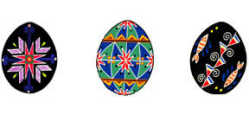Egg-decorating is more than an Easter activity

Egg decorating is an ancient folk art in many parts of the world and particularly in Ukraine, where people design eggs dipped in wax called "Pysanky."
A special program featuring Pysanky-egg decorating will be offered Saturday, April 5 from 3-4:30 p.m. at the Putnam County Library in the Kiwanis Room.
The program will be led by Pysanky-maker Carol Powers, who is also featured in the library's Traditional Arts Indiana panel located at the top of the stairs leading to the Adult Area.
Powers learned the tradition from her aunt. She says she finds joy and meaning in the ornate figures, patterns and colors of the Ukrainian art.
The art form consists of decorating eggs using beeswax and dyes and is more than 6,000 years old. It dates back to the Neolithic Era, when ancient man still lived in caves, and hunted and gathered for food.
Preserving an animal's image on an egg ensured the eminent capture of the hunted creature. Drawing plants or other objects brought that object to man. It was a way of worshipping and harboring the spirit or essence of the animal or object that was drawn.
Ancient designs, predominantly white, brown and black, represented the natural colors of the earth.
As time progressed, tools became more advanced, the designs on the egg grew in detail and more colors emerged.
Eventually people started giving Pysanky eggs as gifts at births, engagements and weddings. They were also offered as get well gifts.
When Christianity came to Ukraine, the symbolism was incorporated to include Christian meanings.
The star once symbolized the pagan god Altar and now stands for Christ and love. The cross-stood for the four corners of the world and now it represents Christianity.
Other symbols include flowers for beauty, pine needles for strength and health, birds for fertility and swirls and snakes for protection from evil. The underlying meanings all wish for love, happiness, health and wealth.
The actual process uses hot wax, which is applied to the egg-using tool called a Kistka. It can be as simple as a stick with a wire holding a tiny stick perpendicular at the end of a larger piece.
There are also electronic versions now available in most hobby stores.
The design begins by drawing on a plain white egg with hot beeswax. When designs are complete, the egg is dipped into yellow dye and dried.
The Kistka is used to draw the next set of designs. The egg is then dipped into the next dye bath.
The process continues, alternating waxing designs and using dyes that get progressively darker.
The most popular Pysanky end with black dye.
Once it is dry, the egg is held over the side of a candle flame and the wax is gently wiped off, revealing a beautifully decorated egg. The egg is then sealed with a coating of shellac or varnish. The ancient art is seeing resurgence and one can often find Pysanky at juried art fairs and festival around the country.
Registration for the class on Saturday is required and the class is limited to 15. Cost is $5 for supplies. To register, call 653-2755, ext. 124 or 115.
